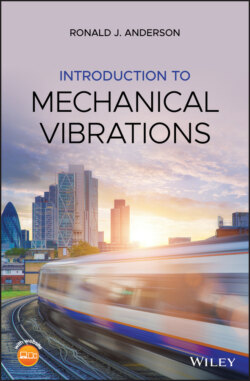Читать книгу Introduction to Mechanical Vibrations - Ronald J. Anderson - Страница 2
Table of Contents
Оглавление1 Cover
2 Preface
4 1 The Transition from Dynamics to Vibrations 1.1 Bead on a Wire: The Nonlinear Equations of Motion 1.2 Equilibrium Solutions 1.3 Linearization 1.4 Summary Exercises Notes
5 2 Single Degree of Freedom Systems – Modeling 2.1 Modeling Single Degree of Freedom Systems Exercises Notes
6 3 Single Degree of Freedom Systems – Free Vibrations 3.1 Undamped Free Vibrations 3.2 Response to Initial Conditions 3.3 Damped Free Vibrations 3.4 Root Locus Exercises Notes
7 4 SDOF Systems – Forced Vibrations – Response to Initial Conditions 4.1 Time Response to a Harmonically Applied Force in Undamped Systems Exercises
8 5 SDOF Systems – Steady State Forced Vibrations 5.1 Undamped Steady State Response to a Harmonically Applied Force 5.2 Damped Steady State Response to a Harmonically Applied Force 5.3 Response to Harmonic Base Motion 5.4 Response to a Rotating Unbalance 5.5 Accelerometers Exercises Notes
9 6 Damping 6.1 Linear Viscous Damping 6.2 Coulomb or Dry Friction Damping 6.3 Logarithmic Decrement Exercises Notes
10 7 Systems with More than One Degree of Freedom 7.1 2DOF Undamped Free Vibrations – Modeling 7.2 2DOF Undamped Free Vibrations – Natural Frequencies 7.3 2DOF Undamped Free Vibrations – Mode Shapes 7.4 Mode Shape Descriptions 7.5 Response to Initial Conditions 7.6 2DOF Undamped Forced Vibrations 7.7 Vibration Absorbers 7.8 The Method of Normal Modes 7.9 The Cart and Pendulum Example 7.10 Normal Modes Example Exercises Notes
11 8 Continuous Systems 8.1 The Equations of Motion for a Taut String 8.2 Natural Frequencies and Mode Shapes for a Taut String 8.3 Vibrations of Uniform Beams Exercises Notes
12 9 Finite Elements 9.1 Shape Functions 9.2 The Stiffness Matrix for an Elastic Rod 9.3 The Mass Matrix for an Elastic Rod 9.4 Using Multiple Elements 9.5 The Two‐noded Beam Element 9.6 Two‐noded Beam Element Vibrations Example Exercises Notes
13 10 The Inerter 10.1 Modeling the Inerter 10.2 The Inerter in the Equations of Motion 10.3 An Examination of the Effect of an Inerter on System Response 10.4 The Inerter as a Vibration Absorber Exercises Notes
14 11 Analysis of Experimental Data 11.1 Typical Test Data 11.2 Transforming to the Frequency Domain – The CFT 11.3 Transforming to the Frequency Domain – The DFT 11.4 Transforming to the Frequency Domain – A Faster DFT 11.5 Transforming to the Frequency Domain – The FFT 11.6 Transforming to the Frequency Domain – An Example 11.7 Sampling and Aliasing 11.8 Leakage and Windowing 11.9 Decimating Data 11.10 Averaging FFTs Exercises Notes
15 12 Topics in Vibrations 12.1 What About the Mass of the Spring? 12.2 Flow‐induced Vibrations 12.3 Self‐Excited Oscillations of Railway Wheelsets 12.4 What is a Rigid Body Mode? 12.5 Why Static Deflection is Very Useful Exercises Notes
16 Appendix A: Least Squares Curve Fitting
17 Appendix B: Moments of Inertia B.1 Parallel Axis Theorem for Moments of Inertia B.2 Moments of Inertia for Commonly Encountered Bodies Notes
18 Index
